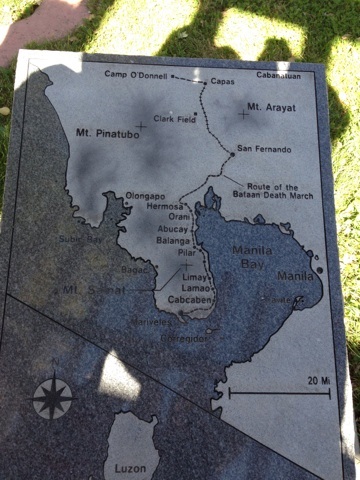Note:Birth date on the headstone is inaccurate.
Henry was born in Raney Township, Greer County, Oklahoma
Henry was able to survive the 70-Mile March, and then he was among those that were loaded onto Box Cars and then traveled to Camp O'Donnell. Which is where he died.
Henry's name along with other soldiers is among the names listed at the Bataan Memorial Park in Albuquerque, New Mexico.
The Bataan Death March was a 70-mile forced march of American and Filipino prisoners of war by Japanese forces during World War II.
Approximately 72,000 American and Filipino soldiers were forced to surrender to the Japanese Army after their defeat in the grinding, three-month-long Battle of Bataan (January 7 - April 9, 1942). The Allied soldiers had not been resupplied for a couple of months, and many were sick and malnourished.
Despite the poor condition of the prisoners, the Japanese command calculated that it would take them only 3 days to march 70 miles through the jungle. Local officers took this order to heart, driving the wounded, ill, and emaciated prisoners relentless through the tropical heat.
The prisoners also were routinely denied food and water.
Anyone who fell behind, complained, had a souvenir taken from a fallen Japanese soldier, or even looked at one of the Japanese wrong was bayoneted or shot. Some prisoners were shot for stopping to fill their canteens at a road-side ditch.
Rifle-butt beatings were common, for offenses such as helping a faltering comrade. Many prisoners were bayoneted for no apparent reason, or for fun. Filipino civilians along the path who offered food or water to the prisoners were also summarily killed by the Japanese.
In total, some 18,000 - 20,000 of the POWs died on the Bataan Death March, which ended up taking one week. Some simply collapsed and died of illness or starvation, but most were murdered. A large but unknown number of the POWs died shortly thereafter in the internment camps as well, from the after-effects of their forced march.
In 1945, the Japanese commander in charge of Bataan, General Homma, was put on trial for atrocities including the Bataan Death March. He stated that he had been unaware of the high death toll from the march until some time later. Nonetheless, he was convicted. General Homma was executed in the Philippines on April 3, 1946.
Henry Appleton Hood is actually buried in the Phillipines. He is one of the ones that were never brought home.
Note:Birth date on the headstone is inaccurate.
Henry was born in Raney Township, Greer County, Oklahoma
Henry was able to survive the 70-Mile March, and then he was among those that were loaded onto Box Cars and then traveled to Camp O'Donnell. Which is where he died.
Henry's name along with other soldiers is among the names listed at the Bataan Memorial Park in Albuquerque, New Mexico.
The Bataan Death March was a 70-mile forced march of American and Filipino prisoners of war by Japanese forces during World War II.
Approximately 72,000 American and Filipino soldiers were forced to surrender to the Japanese Army after their defeat in the grinding, three-month-long Battle of Bataan (January 7 - April 9, 1942). The Allied soldiers had not been resupplied for a couple of months, and many were sick and malnourished.
Despite the poor condition of the prisoners, the Japanese command calculated that it would take them only 3 days to march 70 miles through the jungle. Local officers took this order to heart, driving the wounded, ill, and emaciated prisoners relentless through the tropical heat.
The prisoners also were routinely denied food and water.
Anyone who fell behind, complained, had a souvenir taken from a fallen Japanese soldier, or even looked at one of the Japanese wrong was bayoneted or shot. Some prisoners were shot for stopping to fill their canteens at a road-side ditch.
Rifle-butt beatings were common, for offenses such as helping a faltering comrade. Many prisoners were bayoneted for no apparent reason, or for fun. Filipino civilians along the path who offered food or water to the prisoners were also summarily killed by the Japanese.
In total, some 18,000 - 20,000 of the POWs died on the Bataan Death March, which ended up taking one week. Some simply collapsed and died of illness or starvation, but most were murdered. A large but unknown number of the POWs died shortly thereafter in the internment camps as well, from the after-effects of their forced march.
In 1945, the Japanese commander in charge of Bataan, General Homma, was put on trial for atrocities including the Bataan Death March. He stated that he had been unaware of the high death toll from the march until some time later. Nonetheless, he was convicted. General Homma was executed in the Philippines on April 3, 1946.
Henry Appleton Hood is actually buried in the Phillipines. He is one of the ones that were never brought home.
Inscription
In Memory of PFC Henry A. Hood Who Died May 29, 1942 in the Bataan Death March























